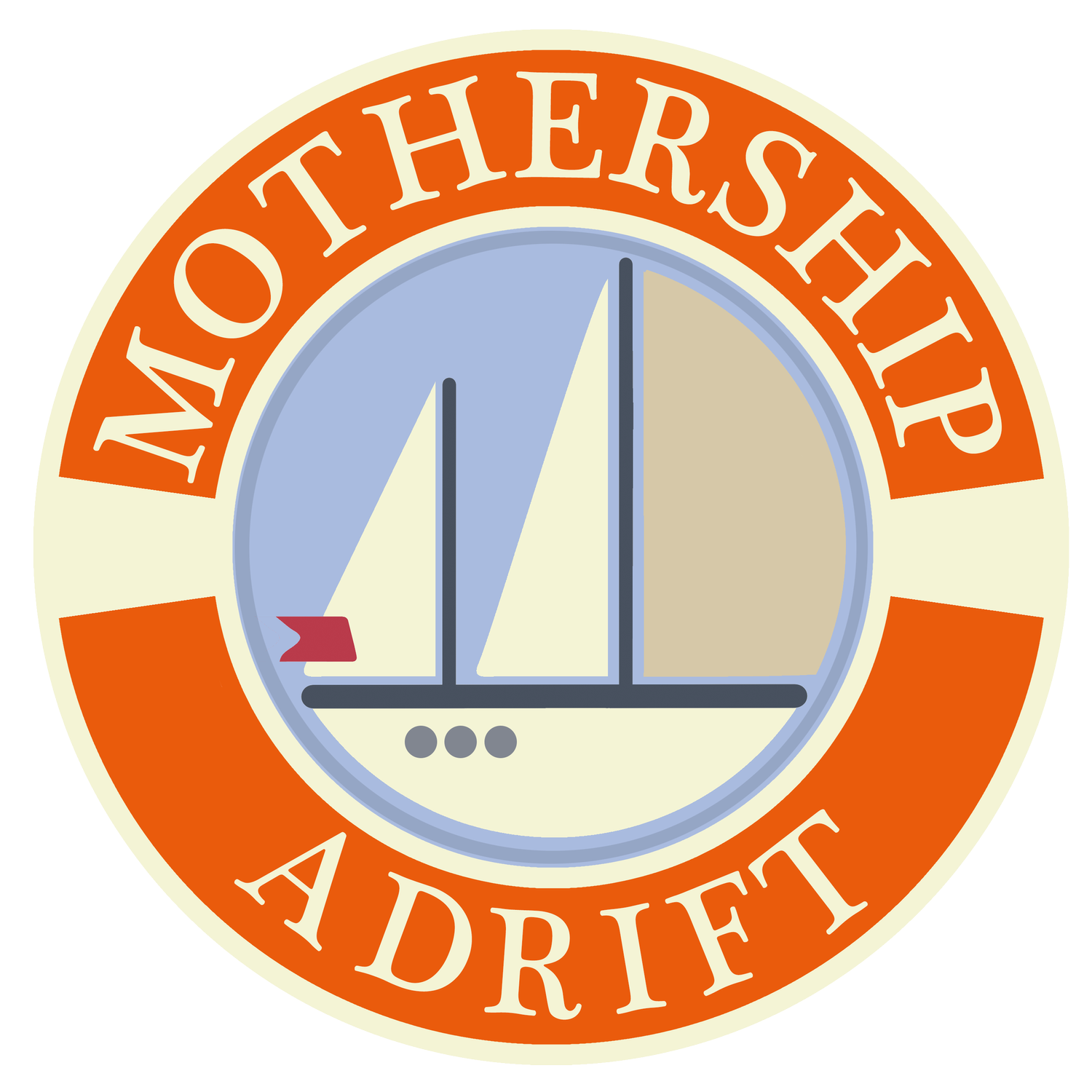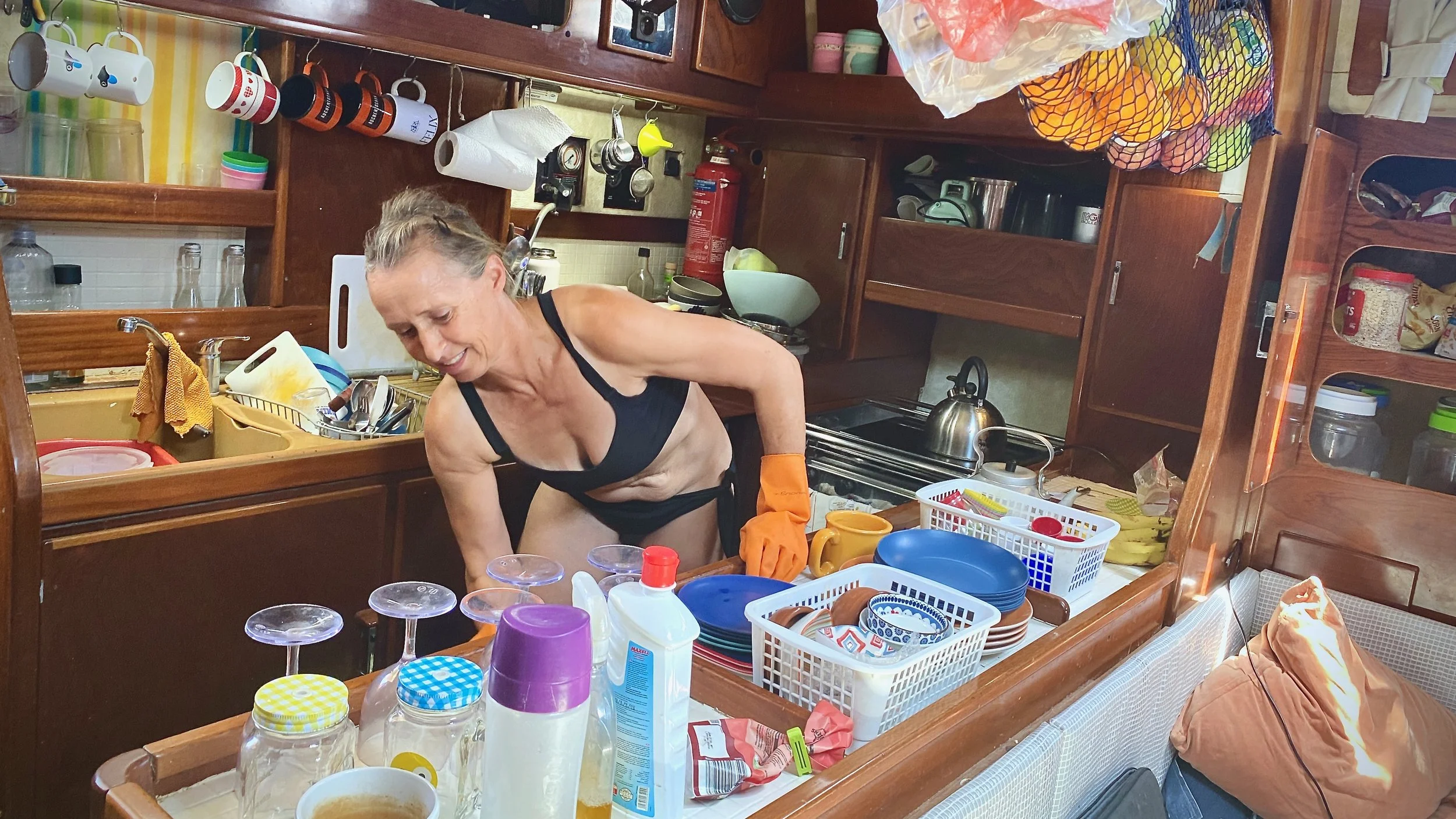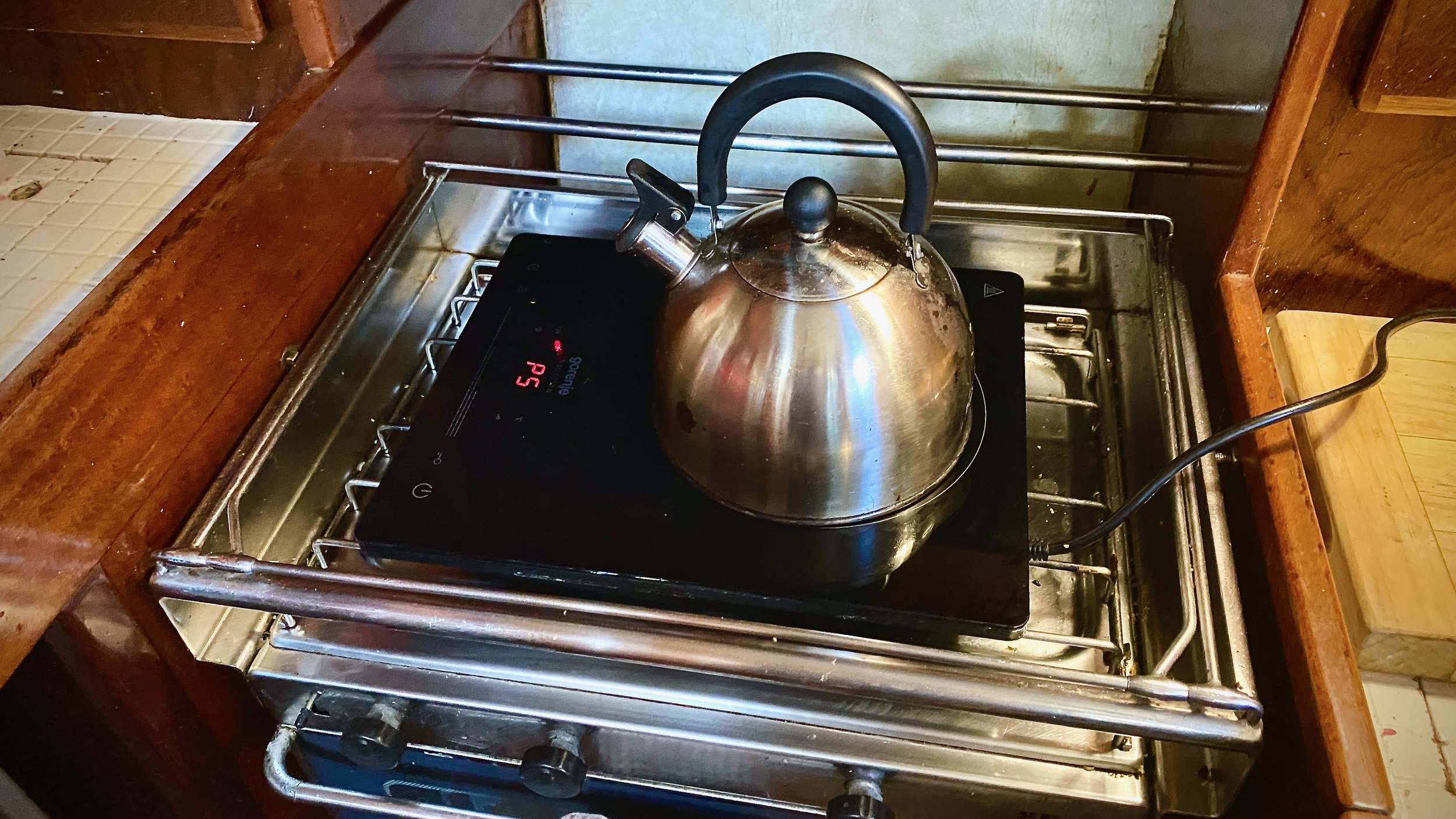A Hitchhiker’s Guide to the Galley
01-04-10
“Time is an illusion. Lunchtime doubly so.”
Irenka in the galley of S/V Mothership
The Galley Fights Back
First, let’s be clear: the galley is not just a kitchen. It’s the epicentre of everything that keeps you alive and props up morale when the rain’s coming in sideways and the nearest supermarket is 800 nautical miles away.
But a galley also heaves, tilts, and bucks. It occasionally throws you at the bulkhead and even tries to kill you. Older boat designers knew this and often added bracing points, restraining bars, and bum straps for cooking underway. These are now rare, especially on catamarans, where galleys resemble the kind of functional kitchenettes you might find in a small, city-centre apartment.
In a marina or at anchor (where 90% of galley action happens), this is great. The crew can cook and eat together with a modicum of safety and civility. But if your galley wasn’t designed by someone who’s actually cooked at sea, you’ll know about it. We’ve known cruising dreams end in excruciating fashion thanks to a fatal combination of hot oil, gimballed hobs, and skimpy swimwear.
The galley is not just a kitchen. It’s the epicentre of everything that keeps you alive and props up morale
Gas vs Electric: The Great Galley Shift
But I’m not a complete luddite. Although I’m from the North of England with a soft spot for the occasional corned beef pie and pickled onion lunch, my family views it as culinary abomination. So I’m fine to move with the times. Besides, I’ve always thought two-burner gas hobs and ovens, once central to galley life, are a pain. Not only is gas temperamental and hazardous, the bottles are awkward to handle and a nightmare to refuel in some countries.
You’ll still find old salty die-hards dumping tinned mince and potatoes into a battered pan on a creaky gas ring with a nostalgic tear in their eye, but solar-charged LiFePO4 batteries are changing everything. Cruisers are adopting renewable-powered gadgets that heat food directly.
What’s not to like?
We added LiFePO4 batteries in Panama and never looked back. The countertop induction hob alone justified it. It sits comfortably on the gimballed gas hob and benefits from the fiddles too.
The countertop induction hob sits comfortably on the gimballed gas hob and benefits from the fiddles too.
In fact, after adding more solar in Thailand, Mothership stopped using the generator entirely. The fact that it crapped out from lack of use was an unfortunate consequence. We haven’t really missed it and can’t justify the expense of bringing it back to life with overpriced, discontinued parts, and this time I’m looking at you Onan/Cummins. On cloudy days, admittedly, we still revert to gas.
Our friends on Tea Time don’t have such worries. They have a whopping 2kW of panels on their Jeanneau 52 and run a full coffee machine and an ice cream maker, serving Baileys cappuccinos and chocolate nib ice cream while hopping through SE Asia. The nibs came from Vanuatu. The beans from Colombia. Proper artisanal, off-grid indulgence.
But storing an army of kitchen appliances is awkward. Sooner or later (usually on a choppy night passage), they break free and go clattering across the galley. We’ve lost every single one of our gadgets over the years, including two microwaves, a halogen oven and several toasters. The pieces still haunt the bilges to this day.
Sooner or later everything in the galley goes clattering across the floor. We’ve lost every single one of our gadgets over the years.
Plates That Stay Put
It goes without saying that crockery and cutlery should be robust and stable. Crockery especially can be a nightmare. Some plates and bowls seem perfectly designed to ski-jump off the edges of galley surfaces. Make sure the rims sit below the lips and fiddles on your worktops and hob.
Stackable crockery is a must for easier storage, and square is definitely more efficient than round, though they do tend to chip at the corners.
Mugs, Lids, and French Priorities
Cups and mugs should fit in proper holders at the helm. Lids help keep things hot and contained, and chunky handles are easier to grip when things get wobbly. Our boat came with built-in cup holders, but they don’t account for mug handles. Being a French boat, however, they fit a wine glass perfectly. No room for tea. Plenty for Cognac. Vive la priorité.
Personally, I prefer my tea in a proper porcelain mug and my wine in actual glass. Plastic cups might be unbreakable, but they also remember every drink you've ever had. Chicken soup at lunch, tea at dinner, beer at sundown, and hot chocolate at midnight. Before too long you're drinking a beverage memory dump.
Personally, I prefer my tea in a proper porcelain mug with a chunky handle
Breakages and Bare Feet
That said, bare feet will always find that one rogue shard of glass or porcelain three months after the inevitable breakage, no matter how well you clean up. So there are compromises: melamine or Corelle are tough options, and tempered glass crockery is about four times stronger than regular glass. It’s not indestructible, but when it does break, it tends to shatter into small, blunt fragments rather than jagged shards.
Cooking on a Tilt
Serving a meal for four or five on a rollicking passage can be a juggling act. We often nominate a designated dish holder, usually one of the kids, to stop dinner ending up on the galley floor. Non-slip silicone matting is essential, in the galley and helm. Some types can even go on induction hobs to stop hot pans skidding into oblivion.
Non-slip silicone matting is essential, in the galley and helm
This might all seem overkill to cruisers on large catamarans who barely spill their tea in conditions that have most monohulls fighting to stay upright. But for monohull crews, it’s the thin rubber line between hot soup and third-degree burns.
Deep Sinks and Galley Duties
Deep sinks are another blessing. They stop washing-up from flying across the galley and double up as handy holders when pouring boiling water. You can wedge your cup or bowl into the sink corner and avoid third-degree scalds.
It’s a good idea having a galley roster, but be prepared to alter it when circumstances dictate. On the open ocean, it takes Irenka some time to find her sea legs, so galley duties tend to fall to me for the first few days while she takes the helm. Which, by the way, is a great cure for seasickness.
It’s a good idea having a galley roster!
Hygiene, Hazards and Holding It Together
Talking of illness, keeping the galley clean isn’t just about being tidy; it’s about survival. On a boat, bugs spread faster than gossip on a dock. We’ve had two full-crew wipeouts: once in Borneo (thanks, Salmonella) and once in Egypt (cheers, Pharaoh’s Curse). Neither were character-building. Just grim.
Regular deep cleans with anti-bacterial products are necessary and it goes without saying that you should wash hands before and after touching food or using the heads. If water’s being rationed, antibacterial wipes or gel are your next best friend.
Paper towels on jumbo rolls are the most useful thing you can buy, but not always available, so stock up where and when you can. Also, damp tea towels shoved into lockers become petri dishes fast, so store them dry, with airflow, or risk an onboard mould farm.
Regular deep cleans with anti-bacterial products are necessary
Fire is another real risk. A powder or CO₂ extinguisher and a fire blanket should be within easy reach, but never directly above the stove. In an emergency, the last thing you want is to reach through flames to get your fire safety kit.
Waste and Vermin
Waste management is a science in itself. Tins, milk cartons, plastic packets and veg peelings build up fast in a small space. So do smells with accompanying flys. I’ll cover trash and vermin in more detail in other sections, but for now, just remember to unpack and decant whatever food you can into sealable, reusable tubs before setting off. Not only does it save space, it stops packaging from breeding like gremlins under the sink.
Organic waste like veg peelings and cardboard can go overboard in moderation, but know your local bylaws. Some officials love flexing their bureaucratic biceps, particularly in place like Turkey. Citrus peel takes longer to break down, but most galley scraps are gone in seconds thanks to hungry fish.
Organic waste like galley scraps can go overboard in moderation, and are gone in seconds thanks to hungry fish.
Cold Storage, Hot Rage
Unless you’ve ripped out your chart table to fit an American double-door fridge (I’m still working on that), cold storage will be tight. We had a conventional fridge and a custom-installed freezer under the saloon seating. Replacing the compressor alone was close to €1000, and it was glassed and screwed in place above the water tank inspection hatch. Gotta love boat designers.
So I ripped the whole thing out and replaced it with a modern 12/24V portable fridge freezer. Maintenance (and associated costs) dropped to zero, and we gained full access to the fresh water tank as a bonus.
As efficient as they are, top-loaders still require daily re-stacking just to find that one tub of yoghurt that’s slipped under the butter and vanished into the void.
I ripped out our old freezer and replaced it with a modern 12/24V portable fridge freezer as can be seen in one of our maintenance videos.
Ice Makers and Rum Stills
But if you want to feel like the most popular kid on the block, serve ice cubes with a sundowner in the tropics. One of our buddy boats, Best Life (teetotallers, mind you) wouldn’t think about leaving shore without their ice maker, and when it broke in the Maldives, they had a replacement flown in before tackling the Red Sea. Because who wants to face pirates, hidden reefs, and terrorists with a warm virgin piña colada?
Another buddy boat (I won’t name names for legal reasons) even converted their second heads into a mini rum distillery.
The moral - select your buddy boats with care!
The galley is the heart of the boat. It’s where moods are lifted, burns are earned, and stories begin. You can’t out-tech the sea, but with a little forethought, a decent battery bank, and crockery that stays put, you might just keep your dinner off the deck and your crew from mutiny.
Bon appetite!
If you want more straight-talking tales from life afloat, and information about galley life, then you’ll love our upcoming book. We're inviting early readers to join the pre-launch crew and get behind-the-scenes access as we wrestle it into shape. It’s honest, unfiltered, and occasionally useful. Sign up here to get involved, give feedback, and be part of something that’ll either be a bestseller or a brilliant cautionary tale.











